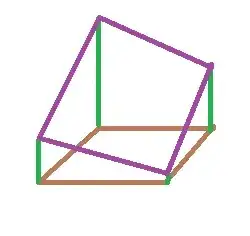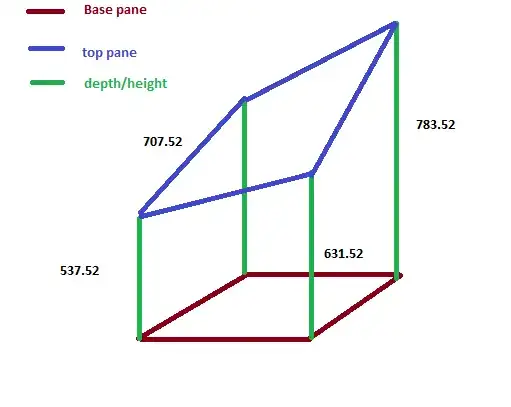The question statement suggests that OP wants the formula for the volume of a truncated right-rectangular (actually -square) prism; however, the sample data doesn't fit this situation. ("Depths" to opposite vertices must sum to the same value, but $30+80 \neq 0 + 120$.) If we allow the table-top to have one or more creases, then OP can subdivide the square prism into triangular ones and use the formula
$$V = \frac{1}{3} A\;(a+b+c)$$
where $A$ is the volume of the triangular base, and $a$, $b$, $c$ are depths to each vertex of the base.
If the table-top really is supposed to be flat ...
Let the base $\square ABCD$ have edge length $s$, and let the depths to the vertices be $a$, $b$, $c$, $d$; let $h$ be the common sum of opposite depths: $h := a+c=b+d$. Then,
$$V = \frac{1}{2} s^2h$$
This follows from the triangular formula, but also from the fact that you can fit such a prism together with its mirror image to make a complete (non-truncated) right prism with parallel square bases. The volume of that figure $s^2h$ is twice as big as we want, because the figure contains two copies of our target.
Edit. OP comments below that the top isn't necessarily flat, and notes elsewhere that only an approximation is expected. So, let's explore the subdivided prism scenario:
As above, our base $\square ABCD$ has side $s$, and the depths to the vertices are $a$, $b$, $c$, $d$. Let $V_A$ be the volume of the truncated triangular prism over right-triangular base $\triangle BCD$; likewise, $V_B$, $V_C$, $V_D$. Then, by the triangular prism volume formula above ...
$$
V_A = \frac{1}{3} \cdot \frac{1}{2} s^2 \cdot \left(b+c+d\right) = \frac{1}{6} s^2 \left(b+c+d \right)
$$
$$
V_B = \frac{1}{6} s^2 \left(a+c+d \right) \qquad
V_C = \frac{1}{6} s^2 \left(a+b+d \right) \qquad
V_D = \frac{1}{6} s^2 \left(a+b+c \right)
$$
Now, $V_A+V_C$ is the volume of the figure where we assume the top is formed by two triangles that meet at a "crease" above diagonal $BD$; and $V_B+V_D$ is the volume when the crease appears above diagonal $AC$. (Note that one of the creases will be a "valley", and one a "ridge".) The desired volume is perhaps somewhere in between, so why not take an average?
$$V = \frac{1}{2}\left( \; (V_A+V_C) + (V_B+V_D) \; \right) = \frac{1}{12}s^2 \left( 3a+3b+3c+3d \right) = \frac{1}{4}s^2 \left( a+b+c+d \right)$$
By the way, we can get the same approximation this way: introduce a new point above the square's center, with a depth equal to the average of the depths at the vertices. Connecting that new point to the vertices creates a "fan" of triangles that approximate the top surface, and each of these triangles hovers over a quarter-square triangular base. The sum of the four triangular solids is the same as our final $V$ above.

